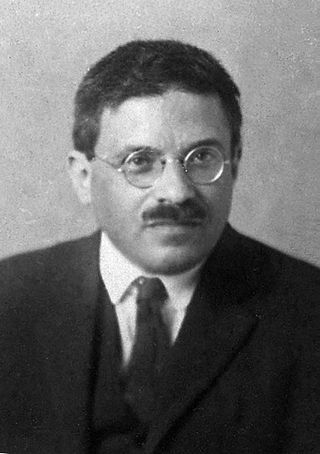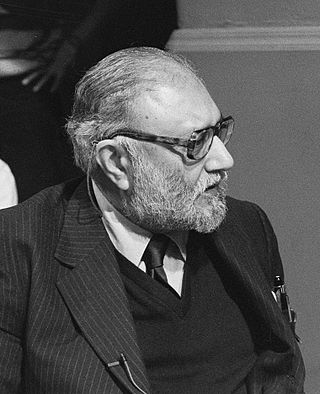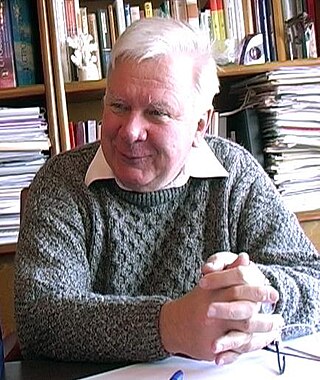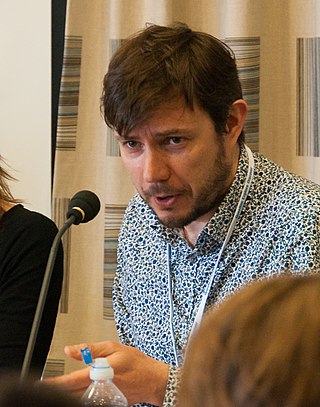Related Research Articles

In particle physics, a fermion is a particle that follows Fermi–Dirac statistics. Fermions have a half-odd-integer spin and obey the Pauli exclusion principle. These particles include all quarks and leptons and all composite particles made of an odd number of these, such as all baryons and many atoms and nuclei. Fermions differ from bosons, which obey Bose–Einstein statistics.

Paul Adrien Maurice Dirac was an English mathematical and theoretical physicist who is considered to be one of the founders of quantum mechanics. Dirac laid the foundations for both quantum electrodynamics and quantum field theory. He was the Lucasian Professor of Mathematics at the University of Cambridge, a professor of physics at Florida State University, and a 1933 Nobel Prize in Physics recipient.

Satyendra Nath Bose was an Indian theoretical physicist and mathematician. He is best known for his work on quantum mechanics in the early 1920s, in developing the foundation for Bose–Einstein statistics and the theory of the Bose–Einstein condensate. A Fellow of the Royal Society, he was awarded India's second highest civilian award, the Padma Vibhushan, in 1954 by the Government of India.

Paul Ehrenfest was an Austrian theoretical physicist who made major contributions to the topic of statistical mechanics and its relations with quantum mechanics, including the theory of phase transition and the Ehrenfest theorem. He befriended Albert Einstein on a visit to Prague in 1912 and became a professor in Leiden, where he frequently hosted Einstein. He died by murder-suicide in 1933; he killed his disabled son Wassik, and then himself.

Mohammad Abdus Salam was a Pakistani theoretical physicist. He shared the 1979 Nobel Prize in Physics with Sheldon Glashow and Steven Weinberg for his contribution to the electroweak unification theory. He was the first Pakistani and the first scientist from an Islamic country to receive a Nobel Prize and the second from an Islamic country to receive any Nobel Prize, after Anwar Sadat of Egypt.

Sir Michael Victor Berry, is a British mathematical physicist at the University of Bristol, England.
Michael Boris Green is a British physicist and a pioneer of string theory. He is a professor of theoretical physics in the School of Physics and Astronomy at Queen Mary University of London, emeritus professor in the Department of Applied Mathematics and Theoretical Physics and a Fellow of Clare Hall, Cambridge. He was Lucasian Professor of Mathematics from 2009 to 2015.

Sir Harrie Stewart Wilson Massey was an Australian mathematical physicist who worked primarily in the fields of atomic and atmospheric physics.

David Ian Olive ; 16 April 1937 – 7 November 2012) was a British theoretical physicist. Olive made fundamental contributions to string theory and duality theory, he is particularly known for his work on the GSO projection and Montonen–Olive duality.

Vladimir Evgen'evich Zakharov was a Soviet and Russian mathematician and physicist. He was Regents' Professor of mathematics at The University of Arizona, director of the Mathematical Physics Sector at the Lebedev Physical Institute, and was on the committee of the Stefanos Pnevmatikos International Award. His research interests covered physical aspects of nonlinear wave theory in plasmas, hydrodynamics, oceanology, geophysics, solid state physics, optics, and general relativity.
John Lawrence CardyFRS is a British–American theoretical physicist. He is best known for his work in theoretical condensed matter physics and statistical mechanics, and in particular for research on critical phenomena and two-dimensional conformal field theory.
David Tong is a British theoretical physicist. He is a professor at the University of Cambridge, working in the Department of Applied Mathematics and Theoretical Physics (DAMTP). He is also a fellow of Trinity College, Cambridge. His research mainly concerns quantum field theory. He is the joint recipient of the 2008 Adams Prize and is currently a Simons Investigator. He is also known for his outreach activities and for his freely available lecture notes covering a wide range of topics in physics.

The Strangest Man: The Hidden Life of Paul Dirac, Quantum Genius is a 2009 biography of quantum physicist Paul Dirac written by British physicist and author, Graham Farmelo, and published by Faber and Faber. The book won the Biography Award at the 2009 Costa Book Awards, and the 2009 Los Angeles Times Book Prize for Science and Technology.

The Principles of Quantum Mechanics is an influential monograph on quantum mechanics written by Paul Dirac and first published by Oxford University Press in 1930. Dirac gives an account of quantum mechanics by "demonstrating how to construct a completely new theoretical framework from scratch"; "problems were tackled top-down, by working on the great principles, with the details left to look after themselves". It leaves classical physics behind after the first chapter, presenting the subject with a logical structure. Its 82 sections contain 785 equations with no diagrams.
Đàm Thanh Sơn is a Vietnamese theoretical physicist working in quantum chromodynamics, applications of string theory and many-body physics.
The William I. Fine Theoretical Physics Institute is a research institute in the University of Minnesota College of Science and Engineering. FTPI was largely the work of physics Professor Emeritus, Stephen Gasiorowicz and university alumnus and Twin Cities real-estate developer William I. Fine. The institute officially came into existence in January 1987. FTPI faculty consists of six permanent members: Andrey V. Chubukov, Alex Kamenev, Keith Olive, Maxim Pospelov, Mikhail Shifman, and Boris Shklovskii. The institute has on Oversight Committee consisting of ten members. The Oversight Committee is the board of directors that make decisions concerning the staffing and budgeting of the institute.
Arthur Mannering Tyndall, CBE, FRS, LLD was an English physicist from Bristol, England. His teaching activities included lecturing in atomic physics at the University of Bristol. Among his notable students was Paul Dirac, who he introduced to the laws of quantum theory. The university's other early staff included John Edward Lennard-Jones, Beryl May Dent, Herbert Wakefield Banks Skinner and William Sucksmith.
Graham Garland Ross was a Scottish theoretical physicist who was the Emeritus Professor of Physics at the University of Oxford and Emeritus Fellow of Wadham College.

Jeffrey Robert Forshaw is a British particle physicist with a special interest in quantum chromodynamics (QCD): the study of the behaviour of subatomic particles, using data from the HERA particle accelerator, Tevatron particle accelerator and the Large Hadron Collider (LHC) at CERN. Since 2004 he has been professor of particle physics in the School of Physics and Astronomy at the University of Manchester.
The Maryland Center for Fundamental Physics (MCFP) is a research institute at the University of Maryland, College Park focused on theoretical physics.
References
- ↑ 2009 Costa Prize for Biography Archived 2012-05-30 at the Wayback Machine
- ↑ 2009 Los Angeles Times Book Prizes
- ↑ Physics World book of the year 2009
- ↑ Brendon, Piers (20 September 2013). "Churchill's Bomb: A Hidden History of Science, War and Politics by Graham Farmelo-review". The Guardian.
- ↑ Farmelo, G.P. Chittenden, D. and Lewenstein, B.V. (eds.) ‘Creating Connections’, AltaMira Press, Walnut Creek, CA. ISBN 0-7591-0475-1
- ↑ Farmelo, G.P. and Carding, J. ‘Here and Now’, Science Museum Publications, London, ISBN 0-901805-97-1
- ↑ Farmelo, G.P. and Bicknell, S. ‘Museum Visitor Studies in the 90s’, Science Museum Publications, London, ISBN 0-901805-61-0
- ↑ 2012 Kelvin Medal and Prize
- ↑ Batchelor, K.W. and Farmelo, G.P., 'A basic design of a chair for hemiplegics with special reference to the back shape', Biomedical Engineering, October 1975, 10 (10), pp 373-8
- ↑ Farmelo, G.P. and Irving, A.C. ‘Regge Pole and Cut Behaviour at Fermilab Energies’, Nuclear Physics B113, Issue 3, 1976, pages 435–444
- ↑ Farmelo, G.P., Bercovich, C. and Smilansky, U., ‘Demonstration of classical chaotic scattering’, European Journal of Physics, Vol. 12 (1991), pages 122-128